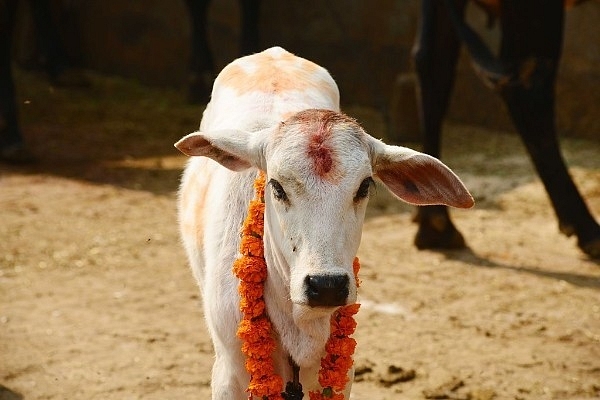News Brief
This District In Uttar Pradesh Turns To ‘Roti Banks’ For Feeding Cows

Representative image of a cow (Ramesh Pathania/Mint via Getty Images)
Mohaba district in Bundelkhand region of Uttar Pradesh has seen an important development towards serving cows in need for food. Ten points in the city have been selected as food collection points from which food is collected and sent to cowsheds.
Donors are appreciating the move as it is helping them avoid food wastage and providing a chance to feed cows in need. According to this report, people from all religions are participating in the collection drive.
The collection drive aimed at creating ‘roti banks’ has been initiated by Sarvdharm Bhojan to strengthen the state government's supply of fodder, which at times is not sufficient, as per the report.
Babla, Head of Sarvadharm Bhojan, is quoted as saying: “The food provided by the government generally falls short of requirements. It is very difficult to arrange for food for such a large number of cows, and hence we are taking help from people who are now donating the chapatis and left overs at 10 food-collecting points.”
Food for the needy cows is an issue of concern for cow lovers and animal lovers in general, just as is the paucity of space for cowsheds.
In November last year, according to the Times Of India, the Kamdhenu Aayog wrote to state governments, and municipal corporations on the issue of initiating hostels for cows.
The sentiment towards the care and feeding of needy cows in common in other parts of the country, is increasing, with donors turning to farmers instead of contributing left overs from home. The purpose is to help farmers by buying their produce for feeding cows, and consolidating the chunk for different gaushalas.
It provides local farmers extra income and a boost to their produce, which sometimes is specially grown to meet the donors' demands.
Food donations for cows are also popular in towns and cities in Rajasthan and Madhya Pradesh. Here, instead of rotis, donors prefer to offer fresh green leaves tied in bundles, straight from the agricultural lands. These bundles consist of a combination of greens grown and found locally and season-based.
The most popular among the greens in such donations are rajka, bajra and corn. Donors offer rajka produce, which goes to the cows and gaushalas. Among the three, rajka forms the bulkiest chunk.
The sale of the green bundles peaks during the hours of the opening of temples — usually in the mornings. On days meant for worship and observing of rituals, and festivals in the Hindu calendar, the sale of the rajka bundles spikes.
In many Hindu households, the first chapati or roti made in the kitchen per day is kept for the cows or the gaushala as an offering.
Last year, India’s top cow official, Dr Vallabh Bhai Kathiria had told Swarajya in an interview that one of the missions of the Rashtriya Kamdhenu Aayog was to create sensitivity and awareness among people towards the wellbeing of cows and members of the bovine family, in cities and towns.
In the initiative in Mahoba, organisers are appealing to donors from all walks of life and across religions for donations to the designated collection points, as per the report.
Support Swarajya's 50 Ground Reports Project & Sponsor A Story
Every general election Swarajya does a 50 ground reports project.
Aimed only at serious readers and those who appreciate the nuances of political undercurrents, the project provides a sense of India's electoral landscape. As you know, these reports are produced after considerable investment of travel, time and effort on the ground.
This time too we've kicked off the project in style and have covered over 30 constituencies already. If you're someone who appreciates such work and have enjoyed our coverage please consider sponsoring a ground report for just Rs 2999 to Rs 19,999 - it goes a long way in helping us produce more quality reportage.
You can also back this project by becoming a subscriber for as little as Rs 999 - so do click on this links and choose a plan that suits you and back us.
Click below to contribute.
Latest